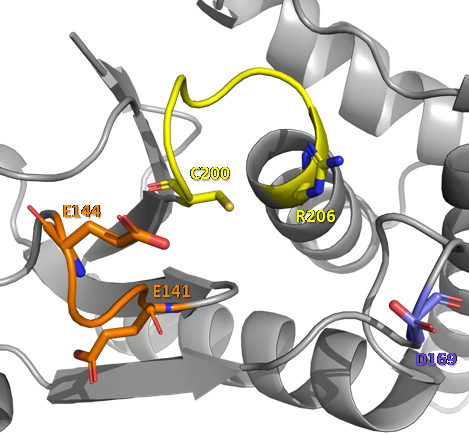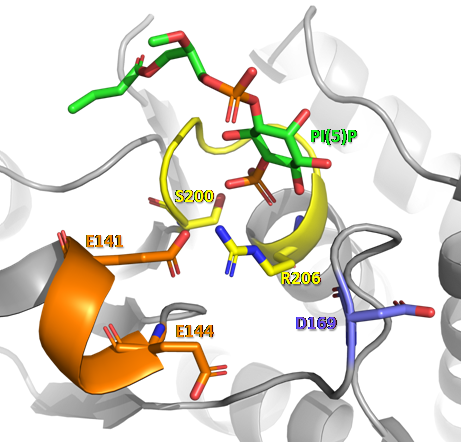User:Luca Paulino Otvos/Sandbox 1
From Proteopedia
| Line 9: | Line 9: | ||
== Biological roles == | == Biological roles == | ||
| - | One of the best known functions of this phosphatase is its participation in the biosynthetic pathway of cardiolipin <ref>DOI 10. | + | One of the best known functions of this phosphatase is its participation in the biosynthetic pathway of cardiolipin <ref>DOI 10.1016/j.cmet.2011.04.007</ref>, a phospholipid that makes up the inner mitochondrial membrane and is essential for metabolic functions, crest structuring and mitochondrial dynamics <ref>DOI 10.3389/fgene.2015.00003</ref>. In this process, PTPMT1 is responsible for the dephosphorylation step of phosphatidylglycerolphosphate (PGP) forming phosphatidylglycerol (PG), which is the substrate of cardiolipin synthase. PTPMT1 is also involved in glucose homeostasis and insulin secretion in pancreatic β cells. The silencing of this phosphatase in the INS-1 832/13 cell line results in a significant increase in ATP production and insulin secretion <ref name="pag"/>. These results were further explained, based on the discovery that PTPMT1 is able to dephosphorylate and, consequently, inactivate succinate dehydrogenase, an enzyme that participates in the reaction of succinate to fumarate, and is probably important in the regulation of this enzyme in the Krebs cycle <ref>DOI 10.1016/j.celrep.2015.01.010</ref>. |
== Disease == | == Disease == | ||
| Line 16: | Line 16: | ||
== Structural highlights == | == Structural highlights == | ||
| - | PTPMT1 is a small protein (210 amino acids in Homo sapiens) characterized by a catalytic domain smaller than that of other PTPs (characteristic of DUSPs) and by the ability to dephosphorylate phosphothreonine, phosphoserine and/or phosphotyrosine residues, in addition to having activity on substrates proteins and lipids <ref>DOI 10. | + | PTPMT1 is a small protein (210 amino acids in ''Homo sapiens'' and 261 amino acids in ''Mus musculus'') characterized by a catalytic domain smaller than that of other PTPs (characteristic of DUSPs) and by the ability to dephosphorylate phosphothreonine, phosphoserine and/or phosphotyrosine residues, in addition to having activity on substrates proteins and lipids <ref>DOI 10.1111/febs.13600</ref> <ref>DOI 10.1016/j.semcdb.2014.09.021</ref> <ref>DOI 10.1016/j.bmcl.2011.10.083</ref>. That protein features three conserved regions essential for its catalytic function: the P loop, D loop, and the EEYE loop <ref>DOI 10.1107/S1399004713029866</ref> <ref name="xiao">DOI 10.1073/pnas.1109290108</ref>. |
| + | The P loop corresponds to the catalytic site of protein tyrosine phosphatases (PTPs). It consists of a catalytic cysteine, followed by any five amino acids and an arginine (CX5R motif). Another conserved region important for the function of this phosphatase is the WPD loop (or D loop in DUSPs), which contains the aspartate necessary for the dephosphorylation reaction to proceed <ref name="xiao"/>. In the initial phase of this process, catalytic cysteine nucleophilically attacks the phosphate of the target residue and aspartate acts as a general acid, donating a proton to the reaction <ref name="denu">DOI 10.1021/bi00010a031</ref>. The conserved arginine of the P loop is extremely relevant during this step, as it guarantees the stability of the penta-coordinated transition state, in which the phosphate makes five bonds, one with catalytic cysteine, another with substrate residue and the too much with its oxygen atoms <ref>DOI 10.1021/bi00255a007</ref>. As a result, an intermediate phosphoenzyme is generated, whose cysteine carries the phosphate group removed from the substrate. Aspartate then acts again, but this time as a general base, removing a proton from a water molecule <ref name="denu"/>. Finally, this water molecule nucleophilically attacks the catalytic cysteine phosphate, breaking the bond between them and restoring the phosphatase conformation (Alonso et al., 2016; Xiao et al., 2011). A third region identified in DUSPs and other PTPs is the “variable insert”, a variable regulatory portion contained between the β3 and β4 strands (or β7 depending on the protein phosphatase) (Yuvaniyama et al., 1996). It is in this region where the EEYE loop characteristic of PTPMT1 and other DUSPs is found (Xiao et al., 2011). Xiao et al. (2011) demonstrated the importance of the EEYE loop for the PTPMT1 phosphatase function, based on mutations in the glutamate residues of this loop. Alterations in E141A and E144A resulted in a marked decrease in PTPMT1 activity. Through the analysis of the crystal structure of PTPMT1169-261 in its apo form (PDB 3RGO) and linked to PI(5)P (PDB 3RGQ), it was observed that the EEYE undergoes a major conformational change and these glutamates are responsible for ensuring the proper conformation of the conserved arginine of the catalytic motif. | ||
[[Image:Form1.png]][[Image:Form2.png]] | [[Image:Form1.png]][[Image:Form2.png]] | ||
Revision as of 14:50, 1 November 2021
This is a default text for your page Luca Paulino Otvos/Sandbox 1. Click above on edit this page to modify. Be careful with the < and > signs. You may include any references to papers as in: the use of JSmol in Proteopedia [1] or to the article describing Jmol [2] to the rescue.
|
Contents |
Function
The protein tyrosine phosphatase localized to the Mitochondrion 1 (PTPMT1) is a dual specificity phosphatases (DUSP) that catalyzes the dephosphorylation of phosphothreonine, phosphoserine and/or phosphotyrosine residues in lipid or protein substrates. Its name came from the fact that it was the first phosphatase identified exclusively in mitochondria [3]. PTPMT1 is a phosphatase directed to the mitochondria by an N-terminal sequence and is found anchored in the inner mitochondrial membrane with its phosphatase domain facing the matrix [4].
Biological roles
One of the best known functions of this phosphatase is its participation in the biosynthetic pathway of cardiolipin [5], a phospholipid that makes up the inner mitochondrial membrane and is essential for metabolic functions, crest structuring and mitochondrial dynamics [6]. In this process, PTPMT1 is responsible for the dephosphorylation step of phosphatidylglycerolphosphate (PGP) forming phosphatidylglycerol (PG), which is the substrate of cardiolipin synthase. PTPMT1 is also involved in glucose homeostasis and insulin secretion in pancreatic β cells. The silencing of this phosphatase in the INS-1 832/13 cell line results in a significant increase in ATP production and insulin secretion [4]. These results were further explained, based on the discovery that PTPMT1 is able to dephosphorylate and, consequently, inactivate succinate dehydrogenase, an enzyme that participates in the reaction of succinate to fumarate, and is probably important in the regulation of this enzyme in the Krebs cycle [7].
Disease
Relevance
Structural highlights
PTPMT1 is a small protein (210 amino acids in Homo sapiens and 261 amino acids in Mus musculus) characterized by a catalytic domain smaller than that of other PTPs (characteristic of DUSPs) and by the ability to dephosphorylate phosphothreonine, phosphoserine and/or phosphotyrosine residues, in addition to having activity on substrates proteins and lipids [8] [9] [10]. That protein features three conserved regions essential for its catalytic function: the P loop, D loop, and the EEYE loop [11] [12]. The P loop corresponds to the catalytic site of protein tyrosine phosphatases (PTPs). It consists of a catalytic cysteine, followed by any five amino acids and an arginine (CX5R motif). Another conserved region important for the function of this phosphatase is the WPD loop (or D loop in DUSPs), which contains the aspartate necessary for the dephosphorylation reaction to proceed [12]. In the initial phase of this process, catalytic cysteine nucleophilically attacks the phosphate of the target residue and aspartate acts as a general acid, donating a proton to the reaction [13]. The conserved arginine of the P loop is extremely relevant during this step, as it guarantees the stability of the penta-coordinated transition state, in which the phosphate makes five bonds, one with catalytic cysteine, another with substrate residue and the too much with its oxygen atoms [14]. As a result, an intermediate phosphoenzyme is generated, whose cysteine carries the phosphate group removed from the substrate. Aspartate then acts again, but this time as a general base, removing a proton from a water molecule [13]. Finally, this water molecule nucleophilically attacks the catalytic cysteine phosphate, breaking the bond between them and restoring the phosphatase conformation (Alonso et al., 2016; Xiao et al., 2011). A third region identified in DUSPs and other PTPs is the “variable insert”, a variable regulatory portion contained between the β3 and β4 strands (or β7 depending on the protein phosphatase) (Yuvaniyama et al., 1996). It is in this region where the EEYE loop characteristic of PTPMT1 and other DUSPs is found (Xiao et al., 2011). Xiao et al. (2011) demonstrated the importance of the EEYE loop for the PTPMT1 phosphatase function, based on mutations in the glutamate residues of this loop. Alterations in E141A and E144A resulted in a marked decrease in PTPMT1 activity. Through the analysis of the crystal structure of PTPMT1169-261 in its apo form (PDB 3RGO) and linked to PI(5)P (PDB 3RGQ), it was observed that the EEYE undergoes a major conformational change and these glutamates are responsible for ensuring the proper conformation of the conserved arginine of the catalytic motif.
References
- ↑ Hanson, R. M., Prilusky, J., Renjian, Z., Nakane, T. and Sussman, J. L. (2013), JSmol and the Next-Generation Web-Based Representation of 3D Molecular Structure as Applied to Proteopedia. Isr. J. Chem., 53:207-216. doi:http://dx.doi.org/10.1002/ijch.201300024
- ↑ Herraez A. Biomolecules in the computer: Jmol to the rescue. Biochem Mol Biol Educ. 2006 Jul;34(4):255-61. doi: 10.1002/bmb.2006.494034042644. PMID:21638687 doi:10.1002/bmb.2006.494034042644
- ↑ Pagliarini DJ, Worby CA, Dixon JE. A PTEN-like phosphatase with a novel substrate specificity. J Biol Chem. 2004 Sep 10;279(37):38590-6. doi: 10.1074/jbc.M404959200. Epub 2004 , Jul 9. PMID:15247229 doi:http://dx.doi.org/10.1074/jbc.M404959200
- ↑ 4.0 4.1 Pagliarini, D.J., Wiley, S.E., Kimple, M.E., Dixon, J.R., Kelly, P., Worby, C.A., Casey, P.J., Dixon, J.E., 2005. Involvement of a mitochondrial phosphatase in the regulation of ATP production and insulin secretion in pancreatic beta cells. Mol. Cell 19, 197–207. https://doi.org/10.1016/j.molcel.2005.06.008
- ↑ Zhang J, Guan Z, Murphy AN, Wiley SE, Perkins GA, Worby CA, Engel JL, Heacock P, Nguyen OK, Wang JH, Raetz CR, Dowhan W, Dixon JE. Mitochondrial phosphatase PTPMT1 is essential for cardiolipin biosynthesis. Cell Metab. 2011 Jun 8;13(6):690-700. doi: 10.1016/j.cmet.2011.04.007. PMID:21641550 doi:http://dx.doi.org/10.1016/j.cmet.2011.04.007
- ↑ Lu YW, Claypool SM. Disorders of phospholipid metabolism: an emerging class of mitochondrial disease due to defects in nuclear genes. Front Genet. 2015 Feb 3;6:3. doi: 10.3389/fgene.2015.00003. eCollection 2015. PMID:25691889 doi:http://dx.doi.org/10.3389/fgene.2015.00003
- ↑ Nath AK, Ryu JH, Jin YN, Roberts LD, Dejam A, Gerszten RE, Peterson RT. PTPMT1 Inhibition Lowers Glucose through Succinate Dehydrogenase Phosphorylation. Cell Rep. 2015 Feb 10;10(5):694-701. doi: 10.1016/j.celrep.2015.01.010. Epub 2015, Feb 5. PMID:25660020 doi:http://dx.doi.org/10.1016/j.celrep.2015.01.010
- ↑ Alonso A, Pulido R. The extended human PTPome: a growing tyrosine phosphatase family. FEBS J. 2016 Apr;283(8):1404-29. doi: 10.1111/febs.13600. Epub 2015 Dec 16. PMID:26573778 doi:http://dx.doi.org/10.1111/febs.13600
- ↑ Lee H, Yi JS, Lawan A, Min K, Bennett AM. Mining the function of protein tyrosine phosphatases in health and disease. Semin Cell Dev Biol. 2015 Jan;37:66-72. doi: 10.1016/j.semcdb.2014.09.021. Epub, 2014 Sep 26. PMID:25263013 doi:http://dx.doi.org/10.1016/j.semcdb.2014.09.021
- ↑ Park H, Kim SY, Kyung A, Yoon TS, Ryu SE, Jeong DG. Structure-based virtual screening approach to the discovery of novel PTPMT1 phosphatase inhibitors. Bioorg Med Chem Lett. 2012 Jan 15;22(2):1271-5. doi: 10.1016/j.bmcl.2011.10.083. , Epub 2011 Nov 3. PMID:22115589 doi:http://dx.doi.org/10.1016/j.bmcl.2011.10.083
- ↑ Jeong DG, Wei CH, Ku B, Jeon TJ, Chien PN, Kim JK, Park SY, Hwang HS, Ryu SY, Park H, Kim DS, Kim SJ, Ryu SE. The family-wide structure and function of human dual-specificity protein phosphatases. Acta Crystallogr D Biol Crystallogr. 2014 Feb;70(Pt 2):421-35. doi:, 10.1107/S1399004713029866. Epub 2014 Jan 29. PMID:24531476 doi:http://dx.doi.org/10.1107/S1399004713029866
- ↑ 12.0 12.1 Xiao J, Engel JL, Zhang J, Chen MJ, Manning G, Dixon JE. Structural and functional analysis of PTPMT1, a phosphatase required for cardiolipin synthesis. Proc Natl Acad Sci U S A. 2011 Jul 5. PMID:21730175 doi:10.1073/pnas.1109290108
- ↑ 13.0 13.1 Denu JM, Zhou G, Guo Y, Dixon JE. The catalytic role of aspartic acid-92 in a human dual-specific protein-tyrosine-phosphatase. Biochemistry. 1995 Mar 14;34(10):3396-403. doi: 10.1021/bi00010a031. PMID:7880835 doi:http://dx.doi.org/10.1021/bi00010a031
- ↑ Zhang ZY, Wang Y, Wu L, Fauman EB, Stuckey JA, Schubert HL, Saper MA, Dixon JE. The Cys(X)5Arg catalytic motif in phosphoester hydrolysis. Biochemistry. 1994 Dec 27;33(51):15266-70. doi: 10.1021/bi00255a007. PMID:7803389 doi:http://dx.doi.org/10.1021/bi00255a007


